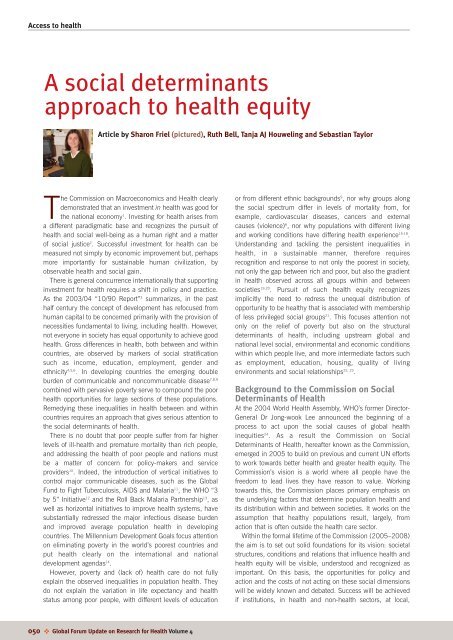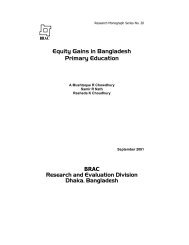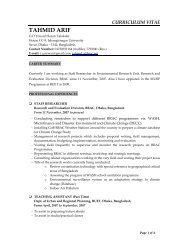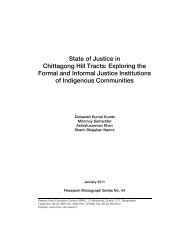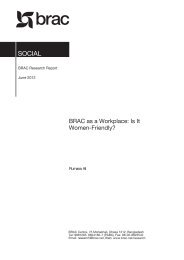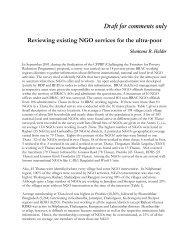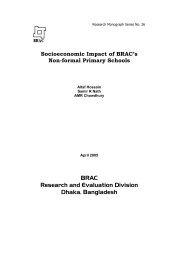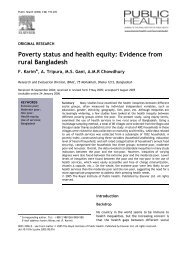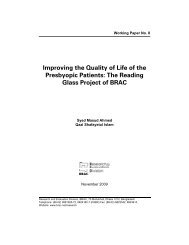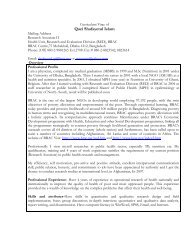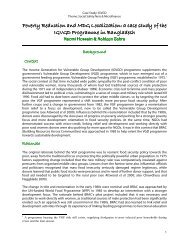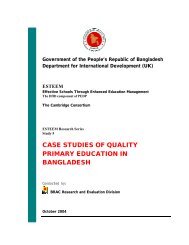Combining health and social protection measures to reach the ultra ...
Combining health and social protection measures to reach the ultra ...
Combining health and social protection measures to reach the ultra ...
Create successful ePaper yourself
Turn your PDF publications into a flip-book with our unique Google optimized e-Paper software.
Access <strong>to</strong> <strong>health</strong><br />
A <strong>social</strong> determinants<br />
approach <strong>to</strong> <strong>health</strong> equity<br />
Article by Sharon Friel (pictured), Ruth Bell, Tanja AJ Houweling <strong>and</strong> Sebastian Taylor<br />
The Commission on Macroeconomics <strong>and</strong> Health clearly<br />
demonstrated that an investment in <strong>health</strong> was good for<br />
<strong>the</strong> national economy 1 . Investing for <strong>health</strong> arises from<br />
a different paradigmatic base <strong>and</strong> recognizes <strong>the</strong> pursuit of<br />
<strong>health</strong> <strong>and</strong> <strong>social</strong> well-being as a human right <strong>and</strong> a matter<br />
of <strong>social</strong> justice 2 . Successful investment for <strong>health</strong> can be<br />
measured not simply by economic improvement but, perhaps<br />
more importantly for sustainable human civilization, by<br />
observable <strong>health</strong> <strong>and</strong> <strong>social</strong> gain.<br />
There is general concurrence internationally that supporting<br />
investment for <strong>health</strong> requires a shift in policy <strong>and</strong> practice.<br />
As <strong>the</strong> 2003/04 “10/90 Report” 3 summarizes, in <strong>the</strong> past<br />
half century <strong>the</strong> concept of development has refocused from<br />
human capital <strong>to</strong> be concerned primarily with <strong>the</strong> provision of<br />
necessities fundamental <strong>to</strong> living, including <strong>health</strong>. However,<br />
not everyone in society has equal opportunity <strong>to</strong> achieve good<br />
<strong>health</strong>. Gross differences in <strong>health</strong>, both between <strong>and</strong> within<br />
countries, are observed by markers of <strong>social</strong> stratification<br />
such as income, education, employment, gender <strong>and</strong><br />
ethnicity 4,5,6 . In developing countries <strong>the</strong> emerging double<br />
burden of communicable <strong>and</strong> noncommunicable disease 7,8,9<br />
combined with pervasive poverty serve <strong>to</strong> compound <strong>the</strong> poor<br />
<strong>health</strong> opportunities for large sections of <strong>the</strong>se populations.<br />
Remedying <strong>the</strong>se inequalities in <strong>health</strong> between <strong>and</strong> within<br />
countries requires an approach that gives serious attention <strong>to</strong><br />
<strong>the</strong> <strong>social</strong> determinants of <strong>health</strong>.<br />
There is no doubt that poor people suffer from far higher<br />
levels of ill-<strong>health</strong> <strong>and</strong> premature mortality than rich people,<br />
<strong>and</strong> addressing <strong>the</strong> <strong>health</strong> of poor people <strong>and</strong> nations must<br />
be a matter of concern for policy-makers <strong>and</strong> service<br />
providers 10 . Indeed, <strong>the</strong> introduction of vertical initiatives <strong>to</strong><br />
control major communicable diseases, such as <strong>the</strong> Global<br />
Fund <strong>to</strong> Fight Tuberculosis, AIDS <strong>and</strong> Malaria 11 , <strong>the</strong> WHO “3<br />
by 5” Initiative 12 <strong>and</strong> <strong>the</strong> Roll Back Malaria Partnership 13 , as<br />
well as horizontal initiatives <strong>to</strong> improve <strong>health</strong> systems, have<br />
substantially redressed <strong>the</strong> major infectious disease burden<br />
<strong>and</strong> improved average population <strong>health</strong> in developing<br />
countries. The Millennium Development Goals focus attention<br />
on eliminating poverty in <strong>the</strong> world’s poorest countries <strong>and</strong><br />
put <strong>health</strong> clearly on <strong>the</strong> international <strong>and</strong> national<br />
development agendas 14 .<br />
However, poverty <strong>and</strong> (lack of) <strong>health</strong> care do not fully<br />
explain <strong>the</strong> observed inequalities in population <strong>health</strong>. They<br />
do not explain <strong>the</strong> variation in life expectancy <strong>and</strong> <strong>health</strong><br />
status among poor people, with different levels of education<br />
or from different ethnic backgrounds 9 , nor why groups along<br />
<strong>the</strong> <strong>social</strong> spectrum differ in levels of mortality from, for<br />
example, cardiovascular diseases, cancers <strong>and</strong> external<br />
causes (violence) 6 , nor why populations with different living<br />
<strong>and</strong> working conditions have differing <strong>health</strong> experience 15-18 .<br />
Underst<strong>and</strong>ing <strong>and</strong> tackling <strong>the</strong> persistent inequalities in<br />
<strong>health</strong>, in a sustainable manner, <strong>the</strong>refore requires<br />
recognition <strong>and</strong> response <strong>to</strong> not only <strong>the</strong> poorest in society,<br />
not only <strong>the</strong> gap between rich <strong>and</strong> poor, but also <strong>the</strong> gradient<br />
in <strong>health</strong> observed across all groups within <strong>and</strong> between<br />
societies 19,20 . Pursuit of such <strong>health</strong> equity recognizes<br />
implicitly <strong>the</strong> need <strong>to</strong> redress <strong>the</strong> unequal distribution of<br />
opportunity <strong>to</strong> be <strong>health</strong>y that is associated with membership<br />
of less privileged <strong>social</strong> groups 21 . This focuses attention not<br />
only on <strong>the</strong> relief of poverty but also on <strong>the</strong> structural<br />
determinants of <strong>health</strong>, including upstream global <strong>and</strong><br />
national level <strong>social</strong>, environmental <strong>and</strong> economic conditions<br />
within which people live, <strong>and</strong> more intermediate fac<strong>to</strong>rs such<br />
as employment, education, housing, quality of living<br />
environments <strong>and</strong> <strong>social</strong> relationships 22, 23 .<br />
Background <strong>to</strong> <strong>the</strong> Commission on Social<br />
Determinants of Health<br />
At <strong>the</strong> 2004 World Health Assembly, WHO’s former Direc<strong>to</strong>r-<br />
General Dr Jong-wook Lee announced <strong>the</strong> beginning of a<br />
process <strong>to</strong> act upon <strong>the</strong> <strong>social</strong> causes of global <strong>health</strong><br />
inequities 24 . As a result <strong>the</strong> Commission on Social<br />
Determinants of Health, hereafter known as <strong>the</strong> Commission,<br />
emerged in 2005 <strong>to</strong> build on previous <strong>and</strong> current UN efforts<br />
<strong>to</strong> work <strong>to</strong>wards better <strong>health</strong> <strong>and</strong> greater <strong>health</strong> equity. The<br />
Commission’s vision is a world where all people have <strong>the</strong><br />
freedom <strong>to</strong> lead lives <strong>the</strong>y have reason <strong>to</strong> value. Working<br />
<strong>to</strong>wards this, <strong>the</strong> Commission places primary emphasis on<br />
<strong>the</strong> underlying fac<strong>to</strong>rs that determine population <strong>health</strong> <strong>and</strong><br />
its distribution within <strong>and</strong> between societies. It works on <strong>the</strong><br />
assumption that <strong>health</strong>y populations result, largely, from<br />
action that is often outside <strong>the</strong> <strong>health</strong> care sec<strong>to</strong>r.<br />
Within <strong>the</strong> formal lifetime of <strong>the</strong> Commission (2005–2008)<br />
<strong>the</strong> aim is <strong>to</strong> set out solid foundations for its vision: societal<br />
structures, conditions <strong>and</strong> relations that influence <strong>health</strong> <strong>and</strong><br />
<strong>health</strong> equity will be visible, unders<strong>to</strong>od <strong>and</strong> recognized as<br />
important. On this basis, <strong>the</strong> opportunities for policy <strong>and</strong><br />
action <strong>and</strong> <strong>the</strong> costs of not acting on <strong>the</strong>se <strong>social</strong> dimensions<br />
will be widely known <strong>and</strong> debated. Success will be achieved<br />
if institutions, in <strong>health</strong> <strong>and</strong> non-<strong>health</strong> sec<strong>to</strong>rs, at local,<br />
050 ✜ Global Forum Update on Research for Health Volume 4


